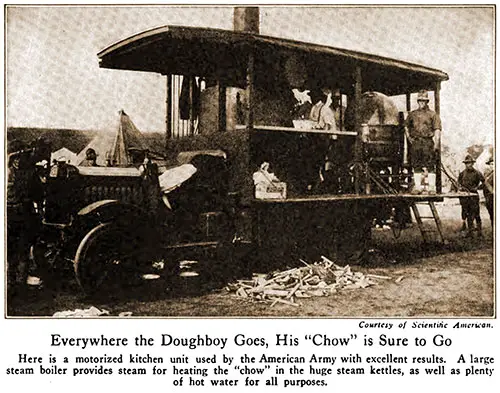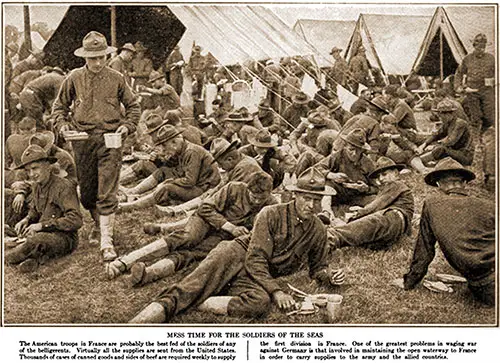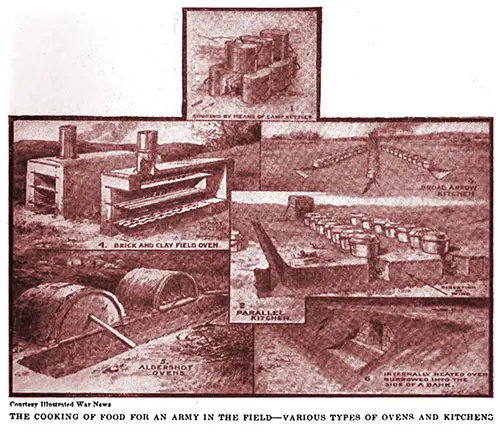Feeding the Men on the Front Lines During World War 1 - 1920

Everywhere the Doughboy Goes, His “Chow” Is Sure to Go. Here Is a Motorized Kitchen Unit Used by the American Army With Excellent Results. a Large Steam Boiler Provides Steam for Heating the “Chow” in the Huge Steam Kettles, as Well as Plenty of Hot Water for All Purposes. Photograph Courtesy of Scientific American. Harper's Pictorial, Vol. 8, 1920. GGA Image ID # 1830c00e4c
The Army Must assure clothes and Cookery to the Men in the field. When an army goes into active service, the commander must take measures at home to provide it with food and clothing. Formerly the invader possessed the right of " booty and pillage"—of taking by force whatever he might need from the inhabitants of the country through which he passed. Nowadays, campaigns are more complex to conduct. Those upon whom the responsibility must fall for the maintenance of the Army in the field take into consideration three factors in particular:
- The time of year and the climate.
- Whether the Army is one of defense or invasion.
- The slow or rapid movement of the forces and the slow or rapid increase or decrease of the distance from their base of supply.

Mess Time for The Soldiers of The Seas. The American Troops to France Are Probably the Best Fed of the Soldiers of Any of the Belligerents. Virtually All the Supplies Are Sent from the United States. Thousands of Cases of Canned Goods and Sides of Beef Are Required Weekly to Supply the First Division to France. One of the Greatest Problems in Waging War against Germany Is That Involved Is in Maintaining the Open Waterway to France in Order to Carry Supplies to the Army and the Allied Countries. Leslie's Photographic Review of the Great War, 1920. GGA Image ID # 1828ea9da8
To make certain that the Army will never lose touch with the home country, the administrative department's work is divided into the service at the rear—i. e., at the home base; the work of the line of communications; the supply-service for the troops in the field during actual engagements. Most important of all is the line of communications.
A general officer of recognized ability and discretion is always placed in command. He is assisted by a large staff and whatever other forces he may require from other service branches. Each day he must forward the necessary supplies for each man and horse, and it is his duty to provide for the evacuation of the sick and wounded and for the custody and care of prisoners.
As we have seen, the Army in the field may subsist, and in times past has subsisted, almost entirely off the country through which it is passing. The custom of pillage has today become that of requisition. The commander usually makes a requisition for an army's food through the mayor or other official of the locality.
He, in turn, collects a war tax from his countrymen and receives from the military a receipt for the same. This sum may later be returned to the inhabitants under an indemnity form, which it is becoming customary to demand after the conclusion of hostilities.
Sometimes the old custom of billeting or quartering soldiers in separate families is revived. As many soldiers are quartered upon a householder as he has members in his family, upon the supposition that he will have provided enough food for a like number of people.
Any householder who has entertained a wounded man in his house is "exempt from the quartering of soldiers." So also are charitable institutions, hospitals, and educational institutions for girls. Unfortunately, this rule is not always observed, nor are the very poor sometimes exempt from this imposition.

The Cooking of Food for an Army in the Field - Various Types of Ovens and Kitchens: 1) Cooking by Means of Camp Kettels; 2) Parallel Kitchen; 3) Broad Arrow Kitchen; 4) Brick and Clay Field Oven; 5) Aldershot Ovens; and 6) Internally Heated Oven Burrowed Into the Side of a Bank (land). Illustration Courtesy of Illustrated War News. The Scientific American War Book, 1915. GGA Image ID # 18d361fb58
It is pleasant for the men at the end of a day's march to find their food already cooked and prepared; on the other hand, the scattering of the troops prevents the enforcement of strict discipline, and the custom, on the whole, is somewhat necessary than admirable.
The field-bakery is an interesting part of the equipment that provided the line of communications forces to supply the fighting-men with bread. It consists of twelve knock-down bake-ovens capable of producing daily eighteen thousand field-bread rations (specially baked with a thick crust to withstand moisture).
The troops, having to march many miles a day, would greatly suffer if compelled always to await the arrival of the train carrying food. Therefore troops in the field must carry rations with them, and the ration consumed during the day must be replaced by the train at night.
The Turks in the fourteenth century first established the allowance of a soldier's daily ration, and the same people first had regularly organized supply-trains to follow their troops. Today the rations in the various armies differ according to racial tastes or climatic conditions.
The meat ration of France, for instance, is quite different from that of Germany. If the German bakers baked all the bread of the German bread ration for one week in one loaf, the loaf would weigh 60,130,000 pounds and stand nearly as high as Cologne Cathedral.
“Feeding the Men on the Firing-Line,” in Harper’s Pictorial Library of the World War, Vol. 11: Child’s Book of the War – Its History and Wonders Told for Young People, New York-London: Harper & Brothers, p. 180.
